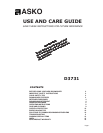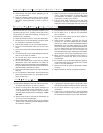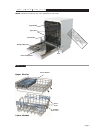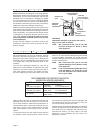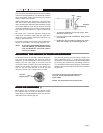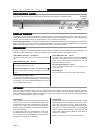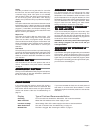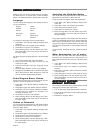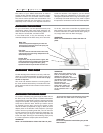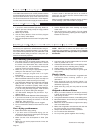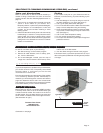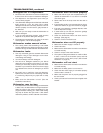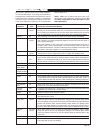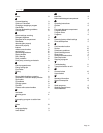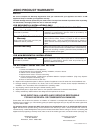
Page 10
Your ASKO dishwasher has an overfill protection device
that automatically shuts off the inlet valve and circulation
pump and starts the drain pump if the water level in the
unit should rise above the normal level. If this happens,
turn the water off at the main supply and call for service.
OO
OO
O
VERFILL PRVERFILL PR
VERFILL PRVERFILL PR
VERFILL PR
OO
OO
O
TECTIONTECTION
TECTIONTECTION
TECTION
If there is water in the base pan due to an overfill or
small leak, the water must be removed before the
dishwasher will start.
When an overfill is detected, the display window will show
a fault message. (See “Fault Codes” on page 8.)
ENERENER
ENERENER
ENER
GY SAGY SA
GY SAGY SA
GY SA
VINGVING
VINGVING
VING
TIPSTIPS
TIPSTIPS
TIPS
♦ If you plan to wash the dishes right away, there’s no
need to pre-rinse. Simply scrape off large particles
and load the dishes.
♦ Wash only full loads.
♦ Use the Heavy Wash or Pots and Pans program
only for heavily soiled dishes.
♦ Don’t use temperatures above 130°F for lightly soiled
dishes.
♦ Use the Express option when washing only slightly
soiled loads.
♦ Use the “Economy” drying option. (You can speed
up the drying process by opening the door slightly to
release the moist air.)
Poor washing performance
♦ The dishes may not be loaded properly. Make sure
that soiled surfaces are facing downward or toward
the center of the dishwasher. Also, make sure that
the bowls, pots, etc., are not stacked so closely that
water can’t reach the soiled surfaces.
♦ Make sure you are using the appropriate program
settings for the dirtiness of your dishes.
♦ Choose a stronger program and/ or a higher
temperature.
♦ An item may be obstructing the spray arm rotation.
With the baskets loaded and in place, manually turn
the spray arms to make sure they move freely.
♦ Your dishwasher detergent should be fresh and stored
tightly closed in a cool, dry place. Old or caked
detergent will not dissolve properly. Wait until you
are ready to start the dishwasher to add the detergent.
If you are using the Delay program, make sure the
dispenser is dry before adding the detergent.
♦ Your dishwasher detergent may be inferior. Try a
different brand.
♦ Make sure the rinse aid dispenser is filled. (See page 6.)
♦ If you have hard water in your area, try adding more
detergent and increasing the amount of rinse aid
dispensed. (See page 4-5.)
♦ Check that the spray arm jets are not clogged.
♦ Do not overload the dishes and be careful to avoid
nesting.
Poor drying performance
♦ Select the Normal drying setting.
♦ If you don’t want to use Normal drying, you can
decrease the drying time by opening the door slightly
to let out the warm, humid air.
♦ Make sure the rinse aid dispenser is filled. (See
page 5.)
♦ Make sure you use the proper amount of rinse aid.
(See page 5.)
SOLSOL
SOLSOL
SOL
UTIONSUTIONS
UTIONSUTIONS
UTIONS
TT
TT
T
O COMMON DISHWO COMMON DISHW
O COMMON DISHWO COMMON DISHW
O COMMON DISHW
ASHING PRASHING PR
ASHING PRASHING PR
ASHING PR
OBLEMSOBLEMS
OBLEMSOBLEMS
OBLEMS
As with any new appliance, it sometimes takes using it a
few times to learn to operate it properly. If you are having
minor performance problems with your dishwasher, read
this section before calling for service. It may save you
time and unnecessary expense.
NOTE:
ASKO has no control over what is put in our
appliances once installed in a customer’s home. You are
solely responsible for what you wash in your ASKO
dishwasher.
♦ Load items with concave bottoms tilted so as much
water as possible will run off.
♦ Unload the bottom basket first to avoid spilling water
onto the dishes when unloading the top basket.
♦ Certain plastics may need to be towel dried.
♦ Load the machine full (1/2 load doesn´t give as good
drying result).
Plastic items
♦ Always check the manufacturer’s suggested care
instructions before washing plastic in your
dishwasher.
♦ Some high-acid foods can discolor plastic. You
should rinse these items if you do not plan to run the
dishwasher right away.
♦ Plastic items dry poorly and may need to be towel
dried.
Chipped or Broken Dishes
♦ When you load the dishes, be sure they’re securely
in place and will not fall over or strike against each
other during the wash.
♦ Load glasses between the tines, not straddling them.
♦ Move the baskets in and out slowly to avoid slamming
the dishes together.
♦ Make sure not to load dishes so high that the spray
arms could strike them.
♦ Make sure tall glasses and stemware will clear the
top of the tub when you push the basket in.
♦ Always load delicate items in the top basket.
♦ Do not overload the dishwasher.
♦ Do not jam the glasses together when loading.
Continued on next page.



